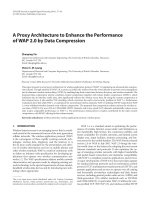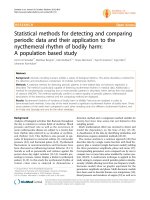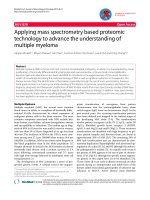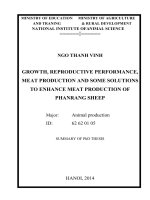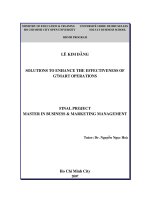Teaching vocabulary through associations to enhance learners understanding of words m a 60 14 10
Bạn đang xem bản rút gọn của tài liệu. Xem và tải ngay bản đầy đủ của tài liệu tại đây (1.91 MB, 136 trang )
VIETNAM NATIONAL UNIVERSITY – HOCHIMINH CITY
UNIVERSITY OF SOCIAL SCIENCES & HUMANITIES
DEPARTMENT OF ENGLISH LINGUISTICS & LITERATURE
TEACHING VOCABULARY THROUGH
ASSOCIATIONS TO ENHANCE
LEARNERS’ UNDERSTANDING OF
WORDS
A thesis submitted to the Faculty of the
Department of English Linguistics & Literature
In partial fulfillment of the Master’s degree in TESOL
By
TRAN THI THANH DIEP
Supervised by
TRAN THI MINH PHUONG, Ph.D
HO CHI MINH CITY, APRIL 2011
CERTIFICATE OF ORIGINALITY
I certify authorship of the thesis submitted today entitled:
TEACHING VOCABULARY THROUGH ASSOCIATIONS TO ENHANCE
LEARNERS’ UNDERSTANDING OF WORDS
in terms of the statement of Requirements for the Theses in Master’s Programmes
issued by the Higher Degree Committee.
This thesis has not been submitted for the award of any degree or diploma in any
other institution.
Ho Chi Minh City, April 20th, 2011
TRẦN THỊ THANH DIỆP
i
RETENTION AND USE OF THE THESIS
I hereby state that I, Trần Thị Thanh Diệp, being the candidate for the degree
of Master of TESOL, accept the requirements of the University relating to the
retention and use of Master’s Theses deposited in the Library.
In terms of these conditions, I agree that the original of my thesis deposited in
the Library should be accessible for purposes of study and research, in accordance
with the normal conditions established by the Library for the care, loan or
reproduction of theses.
Ho Chi Minh City, April 20th, 2011
TRẦN THỊ THANH DIỆP
ii
ACKNOWLEDGEMENT
I would like to express my deepest and sincerest gratitude to my thesis
supervisor, Dr. Trần Thị Minh Phượng, who has provided helpful guidance, precious
comments and strong support in the development and completion of this thesis.
I would also like to acknowledge my debt to colleague teachers at University
of Education – Foreign Language Centre – Branch 4 who have helped and shared
their valuable comments as well as teaching experience related to the scope of this
thesis.
I am also grateful to learners at the above-mentioned language centre,
especially those who have taken part in the questionnaire and the experiment. This
thesis would have never been accomplished without their participation and
involvement in the experiment.
iii
ABSTRACT
This thesis investigates the current situation of teaching and learning
vocabulary and the effectiveness of applying word associations in vocabulary
instruction at HCMC University of Education-Foreign Language Centre, branch 4.
The results indicate that learners’ previous experiences in learning vocabulary
formed a habit of knowing only the meaning of word in Vietnamese and this hindered
their ability of using vocabulary communicatively. Wrong collocations are the biggest
problems and using word associations in vocabulary teaching can help solve these
problems.
Word associations have a lot of benefits. They can motivate learners to
remember new words. They also help learners to avoid common wrong combinations
of words that learners usually make by transferring the meaning of each word from
the first language into the target language. Suggestions of the findings are also
discussed with the emphasis on applying word associations in enhancing the language
teaching quality.
iv
TABLE OF CONTENTS
Certificate of originality ...................................................................................... i
Retention and use of the thesis ........................................................................... ii
Acknowledgement............................................................................................. iii
Abstract............................................................................................................. iv
Table of contents ................................................................................................ v
List of appendices ........................................................................................... viii
List of tables and figures ................................................................................... ix
CHAPTER 1 INTRODUCTION ........................................................................ 1
1.1 Background to the study ........................................................................... 1
1.2 Scope of the thesis.................................................................................... 6
1.3 Research questions ................................................................................... 7
1.4 Aims and significance of the research ...................................................... 7
1.5 Overview of the thesis .............................................................................. 8
CHAPTER 2 LITERATURE REVIEW ............................................................ 9
2.1 Vocabulary acquisition .......................................................................... 9
2.1.1 Definition and the role of vocabulary in language learning.............. 9
2.1.1.1 Definition of vocabulary ................................................. 9
2.1.1.2 The role of vocabulary in language teaching ................. 11
2.1.2 Theory of vocabulary acquisition .................................................. 13
2.1.2.1 Characteristics of vocabulary acquisition ...................... 13
2.1.2.2 Incidental and explicit learning of vocabulary ............... 14
2.1.2.3 Acquisition of word meaning
and morphological knowledge .................................................. 15
2.1.2.4 The role of memory in vocabulary acquisition .............. 15
v
2.1.3 Factors influencing vocabulary acquisition.................................... 16
2.1.3.1 Learners’ motivation ..................................................... 17
2.1.3.2 Learning strategies ........................................................ 18
2.1.3.3 The role of comprehensible input/output ....................... 20
2.1.3.4 The influence of learners’ mother tongue ...................... 20
2.2 Perspectives on vocabulary teaching and learning............................. 21
2.2.1 Teaching vocabulary ..................................................................... 21
2.2.1.1 Explicit teaching and incidental learning....................... 22
2.2.1.2 Ways of dealing with words.......................................... 23
2.2.1.3 Ways of presenting word’s meaning ............................. 25
2.2.2 Learning vocabulary...................................................................... 27
2.2.2.1 Stages of vocabulary growth ......................................... 27
2.2.2.2 Aspects of knowing a word........................................... 29
2.2.2.3 Vocabulary learning strategies ...................................... 31
2.2.3 Testing vocabulary ........................................................................ 33
2.2.3.1 The importance of tests ................................................. 33
2.2.3.2 Purposes of tests ........................................................... 34
2.2.3.3 Typical vocabulary test types ........................................ 34
2.3 Teaching vocabulary through associations ......................................... 36
2.2.1 Definitions of associations ............................................................ 36
2.2.2 Related literature in teaching vocabulary through associations ...... 37
2.2.3 The effectiveness of using associations in vocabulary instruction.. 38
2.2.3.1 Motivating learners to learn vocabulary ........................ 38
2.2.3.2 Raising learners’ awareness of vocabulary .................... 38
2.2.3.3 Enhancing vocabulary size............................................ 39
vi
2.2.3.4 Providing effective activities in recycling the language. 39
2.4 Summary .............................................................................................. 40
CHAPTER 3 METHODOLOGY ..................................................................... 41
3.1 Research questions............................................................................... 41
3.2 Research methodology ......................................................................... 41
3.3 Research design.................................................................................... 42
3.3.1 The questionnaire for learners .................................................. 42
3.3.1.1 Time and setting ........................................................... 42
3.3.1.2 Sample population ........................................................ 42
3.3.1.3 Instrument..................................................................... 43
3.3.2 The questionnaire for teachers .................................................. 45
3.3.2.1 Time and setting ........................................................... 45
3.3.2.2 Sample population ........................................................ 45
3.3.2.3 Instrument..................................................................... 45
3.3.3 The experiment......................................................................... 46
3.3.3.1 Time and setting ........................................................... 46
3.3.3.2 Sample population ........................................................ 47
3.3.3.3 Experiment instrument .................................................. 47
3.4 Data collection procedures .................................................................. 48
3.5 Summary .............................................................................................. 48
CHAPTER 4 DATA ANALYSIS AND FINDINGS ........................................ 49
4.1 Responses to the survey questionnaires ................................................ 49
4.1.1 Responses from learners’ questionnaire .................................... 49
4.1.1.1 Learners’ awareness on the importance of vocabulary .. 49
4.1.1.2 Learners’ current situation in learning vocabulary......... 51
4.1.1.3 Learners’ attitudes towards learning vocabulary through
word associations ..................................................................... 55
vii
4.1.2 Responses from teachers’ questionnaire ..................................... 58
4.1.2.1 Teachers’ opinions on their students’ vocabulary learning
strategies .................................................................................. 58
4.1.2.2 Teachers’ techniques in teaching vocabulary ................ 62
4.1.2.3 Teachers’ judgements on applying associations to teach
vocabulary................................................................................ 65
4.2 Analysis using tests................................................................................. 68
4.2.1 Results from pretest .................................................................. 68
4.2.2 Results from post-test ............................................................... 68
4.2.3 Comparison of the pre-test and post-test scores of two groups .. 69
4.3 Findings .................................................................................................. 71
4.4 Summary................................................................................................. 73
CHAPTER 5 RECOMMENDATIONS AND CONCLUSION ....................... 74
5.1 Summary of main points........................................................................ 74
5.2 Recommendations .................................................................................. 74
5.2.1 To teachers ............................................................................... 75
5.2.2 To learners ............................................................................... 76
5.2.3 Suggested activities of associations to teach vocabulary ........... 77
5.3 Limitations and recommendations for further research ...................... 81
5.3.1 Limitations ............................................................................... 81
5.3.2 Recommendations for further research ..................................... 82
5.4 Conclusion .............................................................................................. 82
REFERENCES.................................................................................................. 84
viii
APPENDICES
Appendix 1 Questionnaire for learners (English version).................................... 88
Appendix 2 Questionnaire for learners (Vietnamese version) ............................. 93
Appendix 3 Questionnaire for teachers (English version) ................................... 98
Appendix 4 Questionnaire for teachers (Vietnamese version)........................... 104
Appendix 5 Pre-test format............................................................................... 110
Appendix 6 Post-test format ............................................................................. 114
Appendix 7 Pre-test and Post-test results of controlled group ........................... 118
Appendix 8 Pre-test and Post-test results of experimental group....................... 120
Appendix 9 Sample lesson plan........................................................................ 122
ix
LIST OF TABLES AND FIGURES
Chapter 1
Table 1.1: List of language contents of the course book used
in the experiment ....................................................................................... 4
Chapter 2
Figure 2.1: Brown and Payne’s five essential steps to learning new words27
Table 2.1: What is involved in knowing a word......................................... 29
Table 2.2: Kinds of vocabulary knowledge and the most effective kind of
learning ......................................................................................... 31
Table 2.3: Vocabulary learning strategies ................................................ 32
Chapter 3
Table 3.1: Summary of learners’ sample characteristics........................... 43
Table 3.2: Summary of teachers’ sample characteristics .......................... 45
Chapter 4
Table 4.1: Learners’ perceptions of the importance of vocabulary in language
learning ................................................................................... 49
Table 4.2: Learners’ self-evaluation of their vocabulary ability................ 50
Table 4.3: Learners’ opinions of the influence of
vocabulary on language skills .................................................. 50
Table 4.4: Learners’ frequency of actual vocabulary learning .................. 51
Table 4.5: Learners’ strategies in learning vocabulary............................. 53
Table 4.6: Learners’ concerns in a new word ........................................... 54
Table 4.7: Learners’ attitudes towards learning vocabulary
x
through associations ............................................................. 55
Table 4.8: Teachers’ opinions of learners’ vocabulary learning strategies 59
Table 4.9: Teachers’ opinions of when learners can remember words ...... 61
Table 4.10: Teachers’ perceptions of the most effective way for learners to
enhance their vocabulary size ................................................ 62
Table 4.11: Teachers’ evaluation of the importance of different aspects of a
word ..................................................................................... 63
Table 4.12: Teachers’ reality in vocabulary teaching .............................. 64
Table 4.13: Teachers’ judgements on the benefits of teaching vocabulary
through associations ...................................................................... 65
Table 4.14: Teachers’ judgements on the difficulties of teaching vocabulary
through associations ...................................................................... 67
Table 4.15: Comparison of the pre/post tests scores of two groups ........... 69
Figure 4.1: Learners’ difficulties in learning vocabulary .......................... 52
Figure 4.2: Learners’ opinions of effective ways to enrich vocabulary ...... 57
Figure 4.3: Learners’ difficulties in learning vocabulary from teachers’
viewpoints.............................................................................. 59
Figure 4.4: Controlled group’s test score distribution............................... 70
Figure 4.5: Experimental group’s test score distribution........................... 70
Chapter 5
Figure 5.1: Suggested activity – word groups............................................ 77
Figure 5.2: Suggested activity – word maps .............................................. 78
Figure 5.3: Suggested activity – word pairs .............................................. 79
Figure 5.4: Suggested activity – opposites................................................. 80
Figure 5.5: Suggested activity – rebus puzzles .......................................... 81
xi
CHAPTER 1
INTRODUCTION
1.1 Background to the study
1.1.1 The problem
Although vocabulary learning is only one sub-goal of a range of goals that are
important in language learning, it does help learners listen, speak, read or write more
effectively (Nation, 2001). Different strategies in learning English vocabulary also
affect learners’ vocabulary development. It is possible to learn a word by simply
memorising it as well as it is also possible to learn a word by examining its roots or
families. However, the writer of this research agrees with Nation (2001) that words
are not isolated units of language but they fit into many interlocking systems and
levels. Therefore, knowing a range of associations for a word helps understand its full
meaning and helps recall the word form or its meaning in appropriate contexts.
Because of this, over the past few years, the teaching of collocation as one of
those word associations in vocabulary development has gained its popularity from
teachers and theorists in many countries and it is also considered one of the best ways
to improve English skills (Hill & Lewis, 1997). The Oxford Collocations dictionary
(2002) emphasizes the importance of collocations in vocabulary development for the
reason that most single words in English, especially the more common words,
embrace a whole range of meanings, some of which are quite distinct, and some shade
into each other by degrees. Therefore, the precise meaning in any context is
determined by the words that surround and combine with the core word, in other
words by collocation.
1
With the knowledge of word associations, learners will be able to use
appropriate word patterns rather than simply put individual words together according
to the English syntactic rules (Wei, 1999). Learners who choose the right associations
for a word will express themselves much more clearly and more naturally.
However, many Vietnamese learners, even at a higher level, still face a lot of
difficulties when they need to express themselves in English. Their difficulties mostly
result from inadequate vocabulary. One of the major reasons for these problems is
their shortage of vocabulary stock. They also depend a lot on their teachers’
explanations when learning vocabulary because they do not know the strategies which
can help them learn vocabulary effectively both in and outside the classroom.
Unfortunately, the lack of suitable vocabulary learning strategies leads to the fact that
learners make wrong combinations of words based on the Vietnamese translation.
Hence there is no doubt that vocabulary knowledge can directly influence the
success of language learning in which it helps learners to enhance the four language
skills. It is the expectation of effectively employing associations for vocabulary
instruction that generated ideas for this study to be conducted.
1.1.2 The need to employ word associations in the teaching and learning
EFL at the Foreign Language Centre of University of Education
(FLC-UE)
Most Vietnamese learners of English at the Foreign Language Centre of
University of Education (FLC-UE) in HCM City have a tendency to learn vocabulary
in isolation without knowing that some words can only combine with some other
particular words. They often believe that they could master English just by learning a
2
great number of words along with the meanings of these words in Vietnamese. As a
result, they often have problems in choosing the right combination of words.
One typical example of wrong combination that learners often make comes
form the adverb of degree “very”. Elementary learners all know the meaning of
“very” and they can make numerous phrases like “very small, very well, very good.”
Assuming that this rule would apply to all words, they produce a sentence like “I very
like football.” Apparently, this sentence is neither correct nor natural English.
Another example of how learners usually associate individual English words
with their equivalent meanings in Vietnamese is also a common mistake among
learners at elementary level. They know the English word “drink” has the same
meaning with “uống” in Vietnamese. Therefore, they make a word pair of “uống
thuốc” as “drink medicine” by just matching the words according to the Vietnamese
equivalents. Instead, we should say “take medicine” although “take” does not share
the same meaning with “uống” in Vietnamese. This is just one among countless
examples to show that vocabulary learning is not simply a matter of matching up
words in the first and the target language.
Such problems of wrong combinations can be avoided when learners approach
vocabulary through its associations. This study aims to investigate the benefits of
using word associations in the teaching and learning of vocabulary at FLC-UE and
make some recommendations from the findings of the research.
1.1.3 Overview of the syllabus
English programmes at FLC-UE (branch 4) offer open courses for learners at
different ages and different English levels who want to improve their English ability
for a variety of purposes. There are programmes for young learners and adult learners
3
as well. The adult English programmes also consist of different levels from beginner
to upper-intermediate ones which aim to develop learners’ proficiency in
communication, especially in the business context. In order to complete elementary
level, learners need to take four courses of eight-weeks’ length each.
1.1.3.1 Description of the course books
At the FLC-UE, adult learners who take part in the general English courses
will use the course book International Express (by Liz Taylor, 2006, OUP). Four
versions of this course book are used corresponding to learners’ levels, which are
elementary, pre-intermediate, intermediate and upper-intermediate. At each level,
there is also the workbook component which provides extra practice of the language
items presented in the student’s book.
The section of the course book which is used in the experiment teaching
contains four units with a review unit for every two units. Each unit is composed of
eight pages dividing into four parts. Part one is the ‘Language Focus 1’ with focuses
on a particular grammar point and exercises. Part two is called the ‘Language Focus
2’ which deals with other language items and practices. Part three which is the
‘Wordpower’ presents vocabulary in different topics. Finally, part four is the ‘Focus
on Communication’ which aims to teach functions by presenting expressions needed
for specific communication situations.
The following table shows the list of language contents in each unit.
Table 1.1: List of language contents on the course book used in the
experiment
Units
Language focus
Wordpower
Focus on
communication
Unit 9
Modal verbs:
Hotel file
4
Invitations
Destination
with a
Suggestions
should/shouldn’t, may,
can/can’t
difference
Past Simple and
Unit 10
Connecting
people
Verbs with
Present Perfect
Present Perfect with
Answerphone
prepositions
messages
Confusing verbs
Emails and
ever
mobile phones
Past Simple Passive
Wordbuilding
Opinions
Unit 11 Reach
Agreeing and
for the sky
disagreeing
Tense review
Describing
Unit 12
people, places
and things
Winning and
keeping
Social
exchanges
Focus on
communication
review
customers
1.1.3.2Teaching methodology
The adult English courses at FLC-UE provide an integrated approach so that
learners can equip themselves with all essential skills necessary for English
communication. Learners do not study the four skills separately but they study all four
skills integratedly. One Vietnamese and one foreign teacher will be in charge of one
class.
5
1.1.3.3 Learners’ characteristics
Learners at FLC-UE have very different backgrounds and thus they have
different English levels. Learners who enroll in the adult courses can be high school
students, university students or working people. Some have studied English before,
some have not, while a few older people need remedial work of the language so they
do not usually have the same vocabulary range. However, they all have one common
purpose, which is to be able to communicate in English effectively. And in order to
reach that goal, they need to have suitable learning strategies, especially vocabulary
learning strategies because vocabulary is one element that links four skills of
listening, speaking, reading and writing all together, according to McCarthy (1990).
1.2 Scope of the thesis
1.2.1 Limitation
The thesis just focused on the experiment and surveys on teaching and learning
vocabulary through associations at late elementary level at FLC-UE, not all aspects
of teaching and learning vocabulary in general, nor at lower or higher levels.
Therefore, the study will not be generalized to all areas of teaching vocabulary to
adult learners.
1.2.2 Subjects
This study is carried out at branch 4 of the FLC-UE in HCMC. The
participants of the study are 60 learners and 10 teachers at elementary level. The
students are studying in two classes and they all study English as a foreign language.
6
1.3 Research questions
The study is designed to examine the reality of teaching and learning of
vocabulary through associations at FLC-UE. The research questions posed in this
study are the following:
1. What is the current situation of teaching and learning vocabulary at FLCUE?
2. In what ways does the technique of teaching vocabulary through
associations benefit learners?
1.4 Aims and significance of the research
1.4.1 Aims of the research
First of all, this thesis aims at analyzing the current situation of teaching and
learning vocabulary at elementary level at FLC-UE in order to find out the problems
that learners usually encounter in learning vocabulary as well as the solutions to these
problems.
Second, the research paper also wants to identify the benefits of using word
associations to teach and learn English vocabulary in elementary classes at FLC-UE,
so that learners can apply this strategy to improve their knowledge of English
vocabulary.
Third, the writer of the research would like to make suggestions about how
vocabulary should be taught through associations in a way that it would help learners
improve their vocabulary competence in order to achieve effectiveness in
communication.
7
1.4.2 Significance of the research
This research paper will help the students of English at FLC-UE be aware of
the importance of word associations in learning vocabulary in order to improve their
spoken and written English.
At the same time, the results of the study will practically contribute to the
teaching and learning vocabulary through associations with communicative approach
at FLC-UE. It also makes recommendations for building the students the base for selfinstruction when they can be independent of their teachers.
1.5 Overview of the thesis
This research is divided into five chapters.
Chapter 1 is the introduction of study, which reveals the reasons why this research is
carried out as well as the purposes that the research aims to and the construction in
which the research follows.
Chapter 2 – Literature Review. This chapter lists related literature and linguistic
knowledge concerning vocabulary teaching and learning.
Chapter 3 – Methodology. This chapter deals with the methodology and design of
the research: how data were collected, the instruments used to collect the data and
how they were analyzed.
Chapter 4 – Data analysis and findings. This chapter presents the findings in
details and analysis and discussions of the research findings.
Chapter 5 – Implications and recommendations. This chapter concludes the study
with summary of all the main points presented in the study and some teaching
implications drawn out from the outcome.
8
CHAPTER 2
LITERATURE REVIEW
In the previous chapter, the rationale of the study in conjunction with
background to the study showed a need to carry out the study. This chapter is a review
of issues relevant to vocabulary teaching and learning: (1) Definition and the
importance of vocabulary in teaching and learning as well as theories of vocabulary
acquisition; (2) perspectives on vocabulary teaching, learning and testing; (3) the
effectiveness of using word associations in vocabulary teaching and learning. The
review provides a theoretical foundation to discuss the teaching techniques and
learning strategies of teachers and learners at FLC-UE and to give feasible
suggestions in order to improve vocabulary teaching and learning.
2.1 VOCABULARY ACQUISITION
2.1.1 Definition and the role of vocabulary in language learning
2.1.1.1 Definition of vocabulary
The concept of vocabulary is rather problematic and it has been studied for
decades without reaching a definite answer. There is no precise and simple definition
of vocabulary or word provided by linguists and researchers.
Schmitt (2000) argues that the term word is too general to cover the various
forms that vocabulary takes. He suggests that to speak of vocabulary in more precise
terms when necessary, especially when handling multiword units, the term lexeme
should be used instead. According to him, lexeme is “an item that functions as a single
meaning unit, regardless of the number of words it contains.” (Schmitt, 2000: 2)
9
Nation (2001) also sees the problems in deciding what is counted as a word.
He recommends four ways of counting words which include tokens, types, lemmas
and word families. Using tokens allows us to count each occurrence of the same word
form when it occurs more than once in a spoken or written text. On the other hand,
types do not count the same word twice if it occurs more than once in the text. When
using lemmas to count words, we usually count a headword and some of its inflected
and reduced forms. Similar to lemmas, a word family also consists of a headword, its
inflected forms plus its closely related derived forms. (Nation, 2001:6-8)
Another attempt to define what a word is comes from Moon (as cited in
Schmitt and McCarthy, 2000). She states that when looking at vocabulary, it is natural
to focus on the word as the primary unit. Therefore, she defines word as “a string of
characters, or a sequence of one or more morphemes, which is bounded at either end
by a space or by punctuation.” (Moon, as cited in Schmitt and McCarthy, 2000: 40)
Another definition of word and vocabulary from a dictionary is also worth
being taken into consideration: a word is “a single unit of language which means
something and can be spoken or written” and vocabulary as “all the words in a
particular language.” (Oxford Advanced Learner’s Dictionary, 2005: 1758&107)
Knowing what is counted as a word would enable us to further explore the
concepts of how vocabulary is acquired by learners when they learn a foreign
language. It would also help to identify the factors influencing the process of
vocabulary acquisition, and hence to find out suitable strategies to enhance
vocabulary size.
10
2.1.1.2 The role of vocabulary in language learning
In the past decades, the role of vocabulary in language teaching has been
treated differently. At times, vocabulary has been given pride of place in teaching
methodologies, and at other times neglected. Schmitt (2000: 22) has summarized the
views on vocabulary through numerous methodologies as follows:
“…Grammar-Translation (with explicit grammar teaching and translation as
language practice), the Direct Method (emphasizing oral skills), the Reading
Method (emphasizing reading and vocabulary control), Audiolingualism
(building good language habits through skills), and Communicative Language
Teaching (with focus on fluency over accuracy).”
Through Schmitt’s summary, it is clear to point out that except the Reading
Method which pays attention to vocabulary control, the other methodologies did not
address vocabulary in any principled way.
Allen (1983) identifies three reasons for the general neglect of vocabulary in
language classrooms in the past. First, grammar received more attention than
vocabulary because many pedagogical experts felt that vocabulary was already being
given too much time in language classrooms. Second, specialists in methodology
feared students would make mistakes in sentence construction if too many words were
learnt before the basic grammar had been mastered. Consequently, teachers were led
to believe it was best not to teach much vocabulary. The third reason comes from a
belief that word meanings can be learnt only through experience, and cannot be
adequately taught in a classroom. As a result, little attention was directed to
techniques for vocabulary teaching. Each of those beliefs about vocabulary is true to a
certain extent.
11
Recently, a lot of researchers have emphasized the importance of vocabulary in
the foreign language classroom partly because of the fact that in many EFL classes,
even where teachers have devoted much time to vocabulary teaching, the results have
been disappointing. One of these researchers, Nation (1990) thinks that vocabulary is
extremely
important
for
both
researchers
and
learners
and
inadequate
receptive/productive vocabulary is an obstacle in using a foreign language effectively.
McCarthy (1990) shares the same opinion with Nation by stating that without words
to express a wider range of meanings, communication in a foreign language cannot
happen meaningfully.
To assert the importance of vocabulary, Vermeer (1992: 47, as cited in Schmitt
and McCarthy, 2000) emphasizes that “knowing words is a key to understand and
being understood”. Therefore, the lack of vocabulary is considered as students’
primary problems in foreign language learning (Carter, 2000).
To summarize the role of vocabulary in language learning, it is helpful to recall
Wilkin’s most famous quote: "without grammar very little can be conveyed; without
vocabulary nothing can be conveyed." (Wilkins, 1972:111), which many language
teachers around the world including the writer of the thesis herself, have used to
remind their learners of how important vocabulary is.
Vocabulary plays important role in language learning because it is words that
carry the content of what we want to say. Grammar joins groups of words together but
most of the meaning is in the words. The more words you know the more you will be
able to communicate. You can say a lot with words but there is not much you can say
with grammar alone.
12
2.1.2 Theory of vocabulary acquisition
2.1.2.1 Characteristics of vocabulary acquisition
According to Maley (as cited in Morgan and Rinvolucri, 1986), the acquisition
of vocabulary involves a number of characteristics described as follows:
First of all, vocabulary acquisition is not a linear but a branching process. By
mentioning branching process, Maley means that words are not learnt mechanically as
little packets of meaning, but they are learnt associatively instead.
Second, he emphasizes that the acquisition of vocabulary is a process which is
intensely personal, not impersonal as a lot of people misunderstood. Therefore, the
associations and vibrations that a word sets up depend on our own past and present
felt experience.
The third feature of vocabulary acquisition is that this acquisition is also not a
solitary but a social process for the reason that we expand our apprehension of word
meanings by interchanging and sharing them with others.
Fourth, Maley claims that vocabulary acquisition is considered as not a purely
intellectual, effortful process but an experiential, ‘hands on’ process too. An overintellectual approach causes the language to be seen as object, rather than to be
incorporated within the subject, who is the learner.
The most important characteristic of vocabulary acquisition, however,
according to Schmitt (2000), lies in its incremental nature. He explains that words are
learnt incrementally, which means they are learnt over a period of time from
numerous exposures before they are acquired. When learners first encounter a new
word, they are likely to pick up some sense of word form and meaning. This can be
the pronunciation of the whole word, or the first few letters of the word. As they gain
13
